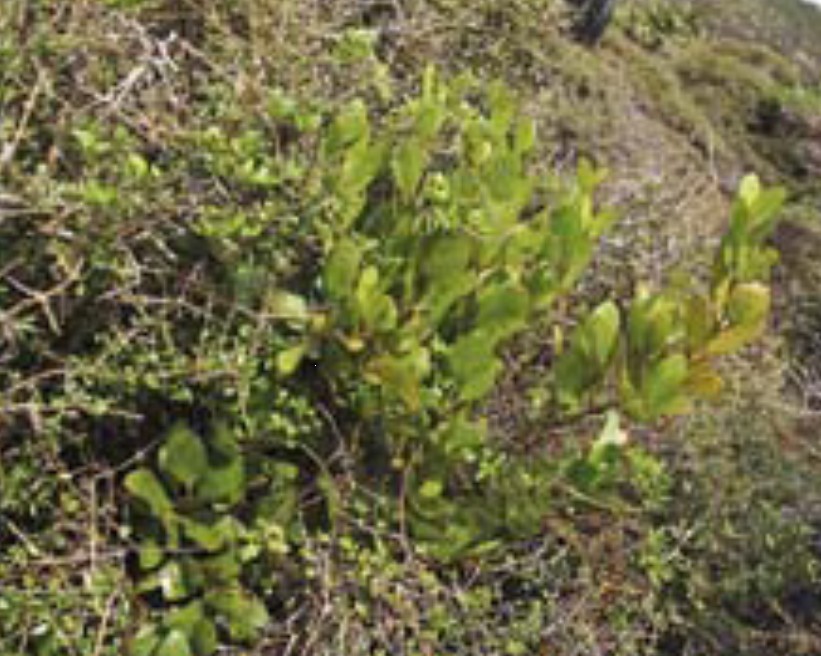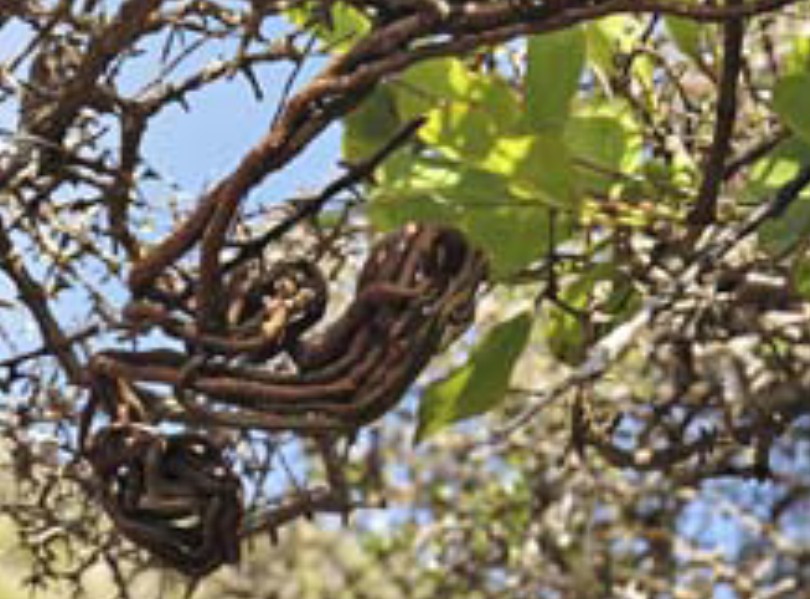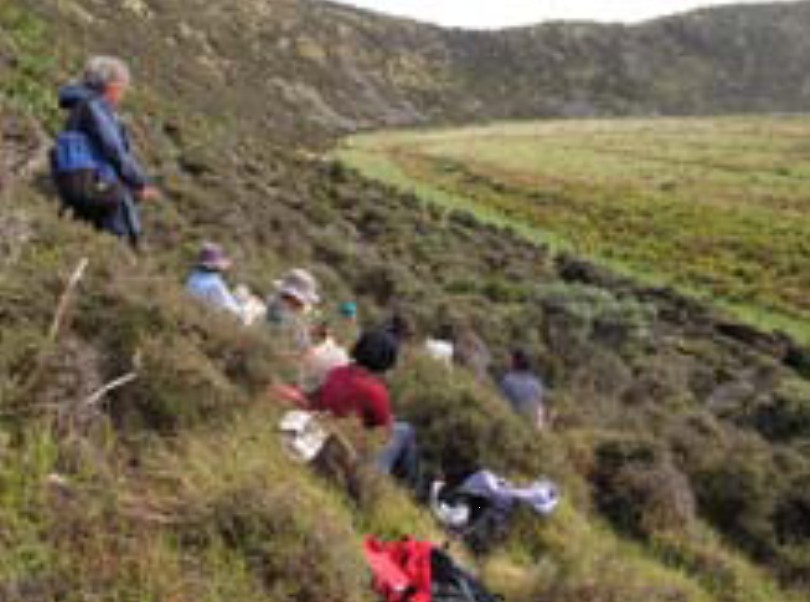Trip Report – 26 March 2011: Baring Head / Orua-pouanui, Wainuiomata
The 284-hectare Baring Head / Orua-pouanui property was purchased in 2010, and added to East Harbour Regional Park. It is classified as “Scenic Reserve”, and managed by Greater Wellington Regional Council. Map: NZTopo50-BQ32 Lower Hutt.
 |
 |
| Ileostylus micranthus (top) and its impressive tangled stems. Photos: Sunita Singh. |
This trip was postponed from 5 March, owing to a poor forecast. Compilation of a plant list for the site began in 2002. We thank Pat Enright for providing the latest edition listing 192 indigenous and 135 adventive plant species. The property runs from Baring Head, 2.3 km up the Wainuiomata Valley, with Coast Road to the east, and Fitzroy Bay to the west. There is a 16-h private enclave on the raised marine terrace. The property contains a diverse range of habitats from coastal turf, dunes, coastal bluffs, wetlands, river estuary, raised beaches, scree slopes, riparian strips, and an extensive ‘grey scrub’ community on the scarp above the true right river flats that intergrades with regenerating broadleaf forest above the “White Bridge”. We started botanising 200 m south from the bridge, along the true right river flats, then screes and “water-pipe gully”, then sidled south to a spur up to Para trig, 167 m, then south along a spur to bluffs, and returned along the river terrace.
The ‘grey scrub’ community includes:
Cordyline australis,
Carmichaelia australis,
Coprosma propinqua subsp.
propinqua,
Ozothamnus leptophyllus,
Clematis forsteri,
Muehlenbeckia complexa,
Parsonsia capsularis,
Rubus squarrosus,
Scandia geniculata,
Tetragonia implexicoma and
Phormium cookianum subsp.
hookeri.
Some more notable plants within this ‘grey scrub’ community are
Brachyglottiis greyi,
Clematis afoliata,
Discaria toumatou,
Muehlenbeckia astonii and two mistletoes,
Ileostylus micranthus and
Korthalsella lindsayi.
NZ ‘grey scrub’ plant communities have evolved in response to the country being surrounded by large tracts of ocean, and being in the Roaring-Forties climatic zone. At Baring Head, severe southerly storms carry salt-laden air 1-2 km inland, restricting vegetation to mainly small-leaved, salt-tolerant shrubs and lianes.
‘Grey scrub’ plant communities are becoming rare, owing to farming practices, people’s desire to live on the coast, and adventive plant invasion, so ‘grey scrub’ has a proposed Conservation Status of “Serious Decline”. Plant Conservation Strategy - Wellington Conservancy (excluding Chatham Islands) 2004 - 2010, p. 42.
Since our 2004 field trip to the property, it has been heavily stocked with cattle and sheep, domestic pigs have run loose, and rabbits, hares and possums have all helped to deplete the ‘grey scrub’, restricting regeneration. Cattle have damaged coastal dune plant communities by trampling and ripping out plants, disturbing the sand substrate. The good news is that cattle will be removed on 31 May 2011.
To prevent further damage, we recommend:
• confining sheep and lambs to pasture in securely-fenced paddocks on river and marine terraces, so that they cannot enter ‘grey scrub’, or other indigenous plant communities on the raised marine terrace, the faces and the cliffs below it, the river terraces and the raised beaches.
• asking the enclave owner to keep his pigs and piglets in secure pens
• trapping / poisoning all mammal-ian pest species, plus magpies, to foster the return of natural functioning of the various eco-systems on the property.
We recommend that Greater Wellington:
• kills gorse (
Ulex europaeus) and boxthorn (
Lycium ferocissimum) promptly, and the old man’s beard (
Clematis vitalba) at GPS E 2667119 N 5976523 before seed is ready to disperse.
• removes the class B noxious plant,
Egeria densa, in the river by the bridge
• kills the
Erica lusitanica on adjacent Coast Road cuttings, but not recorded on the property, to stop it spreading to the property.
 |
| BotSoccers at the Baring Head matagouri site. Photo: Sunita Singh. |
Suggestions for recovery of at-risk plants on the property:
Ileostylus micranthus: in 2004, six plants were known in the lower Wainuiomata Valley, three on the property. By February 2011 none of these plants had survived. However, two more adult plants have been found on the property, near the original site. Unless one of these plants is a female, extinction is inevitable. We recommended that the mistletoe sites be fenced off immediately, until permanent fencing is erected.
Clematis afoliata : the sole plant suffers continuing browse. We recommend that the site be fenced off immediately, until permanent fencing is erected. Plants may be able to be produced from cuttings.
Discaria toumatou : matagouri: though not uncommon here, plants become clogged with exotic grasses, and many have an unhealthy yellow appearance; some die. We recommend that a trial be done using a grass-killing spray to see if this eventually frees the plants of grass. Bare ground under the plants could facilitate recruitment.
Muehlenbeckia astonii : the two plants known were in fruit in March 2011. No seedlings were found among the exotic grasses growing under or near these plants. We recommend that a larger area be fenced off, to exclude sheep, rabbits and hares, and that grass in the enclosure be killed with a grass-killing spray, to see if bare ground will encourage recruitment of genetically diverse plants. If numerous plants result, they can be used for restoration work across the property. Otherwise, cuttings of this plant are easy to strike, and can be used in the interim for restoration work.
For other plants, providing habitat that is free of browsing animals, and predators of native birds and lizards, will allow the natural regeneration processes to work.
If some plantings are considered necessary to speed the recovery process, we recommend that cuttings, seed or divisions of plants be strictly from the property, and plantings blended into existing plant landscapes, to avoid a gardened appearence.
Participants : Margaret Aitken, Gavin Dench. Chris Hopkins (leader / scribe), Chris Horne, Maya Hunt, Rodney Lewington, Mick Parsons, Darea Sherratt, Sunita Singh, Carol West.

 Site Index
Site Index







 Site Index
Site Index





